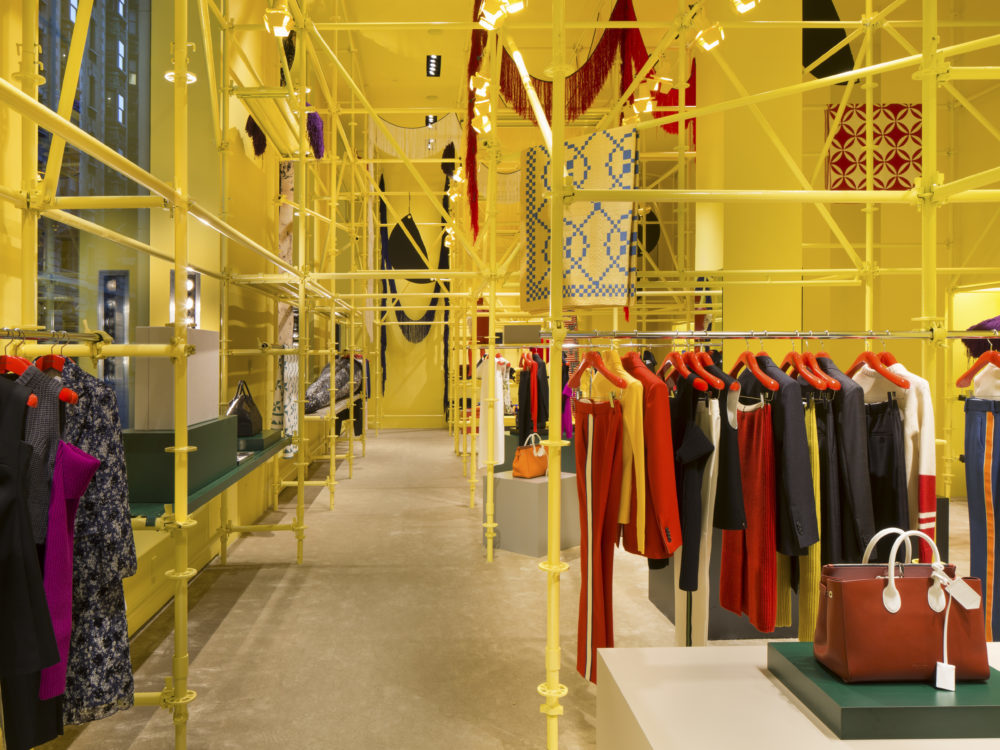
When it comes to creative collaborators, you’d be hard-pressed to find a more prolific duo than fashion designer Raf Simons and artist Sterling Ruby.
Since last year, Simons has been the chief creative officer at the American brand Calvin Klein. It’s a matchup that has thrilled the fashion industry, promising to inject a dose of the designer’s European high-mindedness into the minimalist label popularly known for its provocative advertisements and brilliance at remaking commonplace garments (like jeans and underwear) as designer fashion items.
From the start, Simons has also imported his extensive art-world credibility, launching an indelible ad campaign in the spring that emphatically paired the classic Calvin staples with contemporary art, showing slender models sporting undergarments while contemplating masterpieces. The designer’s love of art is impressively thoroughgoing and eclectic. In a recent Vanity Fair profile, for example, it’s casually mentioned that Simons has a pair of Picasso vases on his desk (!) and that he’s a fan of Warhol, Balthus, Cindy Sherman, Anne Collier, and Cady Noland, among others.
Simons, meanwhile, has had a longstanding work relationship with Ruby, the Los Angeles-based artist known for his large-scale paintings and mixed-media sculptures that bring to mind subjects as disparate as graffiti, the universe, rusting cars, and urban decay. The two have known each other for a decade since being introduced by Ruby’s dealer at the time, and they have collaborated sporadically over the years on such projects as a limited-edition collection of men’s clothing for Simons’ own eponymous label in 2014, textiles for a couture collection that Simons designed while he was at the French label Dior, and, most recently, the newly revamped Calvin Klein 205W38NYC flagship boutique on Madison Avenue.
The exterior of the Madison Avenue Store. (Courtesy of Calvin Klein.)
What was once a sterile white box located at the junction where Midtown Manhattan gives way to the tony Upper East Side, the four-story space is now a riot of color, mainly yellow—a dazzling installation that’s searing, and daring, in its flamboyance. The store is in a holding position of sorts as it awaits a comprehensive remodeling, and Ruby’s work is meant to reflect that impermanence, that state of in-betweenness. Scaffolding intersects with the space as if it were already under construction. From it hang large strips of fringe, oversized tassels, and homespun quilts—textiles that recall Simons’s first collection for Calvin Klein, a cultural interloper’s modernist take on ideas of Americana, ranging from frontier plains to ’50s suburbia to denim-clad rebels.
“I wanted the store to generate a very immediate physical experience that could as well be intimately connected to the collections,” Simons said in a statement. “It is also a continuation of the language I am creating with Sterling for Calvin Klein’s visible and physical identity. The use of very direct and familiar references common to the American visual experience creates a simple and emotional connection with the brand.” The shocking break from the boutique’s past incarnation is purposeful, with art helping craft an about-face in corporate identity. “I’m taking the Calvin Klein flagship store from minimal to maximal,” Ruby said in the statement. “My design should be seen as a marker to celebrate the future of the brand.”
Inside the new store, fashion mixes with art. (Courtesy of Calvin Klein.)
Recently, there’s been a lot of overlap between designers and artists—Jeff Koons designed Old Master-themed bags for Louis Vuitton, for example, which can be seen in their store window directly across from Calvin Klein—but this takes the collaborative process to a new, unexpected place. Does an artist designing a store interior make the space a de facto gallery or experiential art installation? Perhaps that sort of liminal confusion is also baked into Simons and Ruby’s collaborative process, blending the work so comprehensively that the results defy categorization—as art or fashion, gallery or boutique—and forge a new ideal.
One thing’s for certain: thanks to online shopping, consumers are losing interest in brick-and-mortar shops—with malls dying at an alarming rate—so rethinking the concept of what a store can be is a necessary part of retail’s evolution. Wouldn’t a cosmopolitan would-be buyer prefer not to feel like a mere cog in fashion’s seasonal wheel of commerce, but instead something closer to a patron of the arts—a sophisticate who’s buying not a blouse but a piece of cultural capital? In these times when designer clothing has lost much of its exclusive luster, that might be the ultimate fashion accessory: status as a cultural insider. At the very least, the intense yellow is a welcome break from the hushed and tasteful default mode of much store design. It’s refreshing.
No, this is not a blue-chip art gallery. (Courtesy of Calvin Klein.)
Simons, ironically, is still somewhat dubious about the exact relation between art and fashion, and even frowns upon clothes being shown in museums—as with the current Comme des Garcons show at the Met. When asked if he sees himself as an artist, “No,” he tells Vanity Fair. “But maybe I would want to do art. I know people would criticize it once you’ve been defined as a fashion designer…. But it would be a whole different thing. It would be purely a comment that I needed to make, and it would be out there. If I ever would want to do it, it would probably be just because I need to do things…. I would go crazy if I didn’t do my things.” He adds: “The ideas, they have to go out, one way or another.”